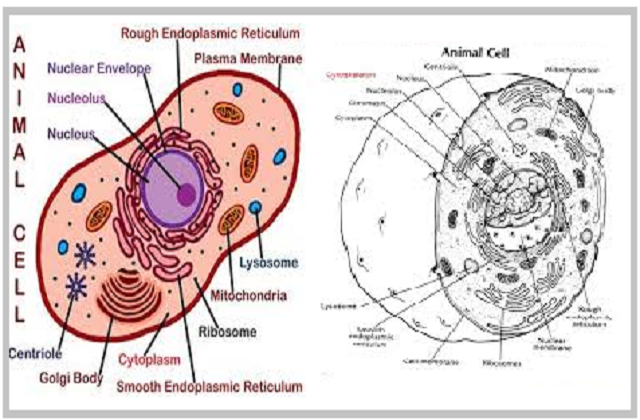Organisms Whose Cells Do Not Have a Nucleus Are Called
How do Organisms Reproduce Class 10 Notes is part of Class 10 Science Notes for Quick Revision. 2 they have multiple cells.

Facts About Cells Environmental Engineering Bachelor Degree Study Program
The domain Eukaryota makes up one of the three domains of life.

. The genetic material DNA help in protein formation. Bacteria and archaea the prokaryotes. Most of the activities of the cell is directed by the nucleus.
Cells are of two types. According to new CBSE Exam Pattern MCQ Questions for Class 10 Science pdf Carries 20 Marks. Primarily eukaryotic cells have a membrane-bound nucleus that houses their DNA.
Cells of animals and some protozoans do not have cell walls to help maintain shape and provide structural stability. There are 5 important organelles for you to know. They form haploid In male and female gametes through the process of meiosis.
Instead these types of eukaryotic cells produce an extracellular matrix for this purpose. All the cells in an animal has one complete set of genes in its nucleus. And each cell has a nucleus and other specialized structures called organelles.
You definitely have to use a microscope to look at the cell details and parts called organelles. They also have other membrane-bound structures called organelles which carry out specific functions within the cells. Some protein components.
The advent of the nucleus which differentiates eukaryotes organisms whose cells contain a true nucleus including humans from prokaryotes such. The organisms within each kingdom have unique characteristics that define them. Their name comes from the Greek εὖ eu well or good and κάρυον karyon nut or kernel.
They secrete a sticky mass of carbohydrates and proteins into the spaces between adjacent cells Figure 19. Eukaryotes j uː ˈ k ær i oʊ t s-ə t s are organisms whose cells have a nucleus enclosed within a nuclear envelope. The nucleus which in real cells often looks like a dark-stained dot contains the DNA and controls the cell.
1 they are unable to make their own food. It is darkly stained are in the nucleus it aids in protein formation and RNA synthesis. CBSE Class 10 Science Notes Chapter 8 How do Organisms Reproduce.
The parents are diploid 2n as each of them has two sets of chromosomes DNAs. Almost all cells are too small to see with the naked eye so we use a tool called a microscope to look at cells. Here we have given NCERT Class 10 Science Notes Chapter 8 How do Organisms Reproduce.
However all eukaryotes also share certain morphology. Animals can be distinguished from other living things by the combination of three features. Bacteria singular bacterium any of a group of microscopic single-celled organisms that live in enormous numbers in almost every environment on Earth from deep-sea vents to deep below Earths surface to the digestive tracts of humans.
Eukaryotes belong to the domain Eukaryota or Eukarya. Bacteria lack a membrane-bound nucleus and other internal structures and are therefore ranked among the unicellular life-forms called. Mitochondria are often introduced as the ATP-producing powerhouses of eukaryotic nucleus-bearing cells but they fulfill essential roles in a number of other cell processes including.
Scientifically put animals are heterotrophic multicellular organisms with eukaryotic cells. Chromosomes are linear strands of DNA and associated proteins that occur in nucleus of eukaryotic cells carry genes and function in transmission of hereditary information. Common Parts of Animal And Plant Cells Nucleolus.
Eukaryotic which contain a nucleus and prokaryotic cells which do not have a nucleus but a nucleoid region is still presentProkaryotes are single-celled organisms while eukaryotes may be either single-celled or multicellular.

Prokaryotic Cells And Eukaryotic Cells Prokaryotic Cell Eukaryotic Cell Prokaryotes

Inside A Nucleus Prokaryotic Cell Eukaryotic Cell Cell Wall

Prokaryotic Cells Article Khan Academy

Cell Model And Structure Of The Endoplasmic Reticulum Cell Model Cell Biology Plant And Animal Cells

What Would Happen If Nucleus Is Removed From The Cell

Cells Poster Print For Shelf Work Micro In The Biology Worksheet Biology Classroom Science Cells

Cell Being The Structural Functional And Biological Unit Of All Living Organisms Is The Smallest Unit Of L Cell Parts Cell Parts And Functions Cell Diagram

File Struttura Della Cellula Vegetale Svg Prokaryotic Cell Cell Biology Plant Cell Diagram

Bagian Bagian Sel Hewan Dan Fungsinya Sampah Otak Animal Cell Cell Model Cell Biology

Plasma Membrane Plasma Membrane Teaching Biology Endocrine System Nursing

Infographic Inside A Cell Infographic Cell Infographic Illustration

Prokaryotic Cell Definition Examples Structure Biology Dictionary

Eukaryote Definition Structure Facts Britannica

Eukaryotic Cell Vs Prokaryotic Cell Difference And Comparison Diffen Prokaryotic Cell Eukaryotic Cell Prokaryotes

Structure And Functions Of Living Organisms Cells Tigers Talking Science

Cell Study Guide Biology 101 Free Biology Study Guides Biology Lessons Study Biology Teaching Biology

Prokaryotic Cell Definition Examples Structure Biology Dictionary


Comments
Post a Comment